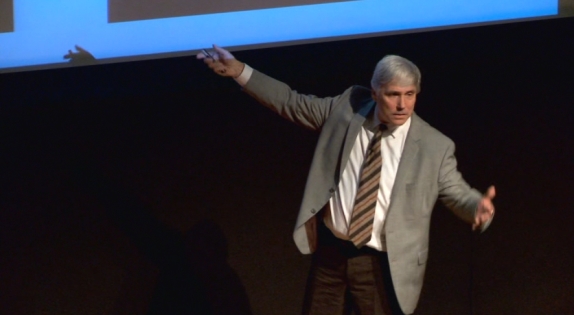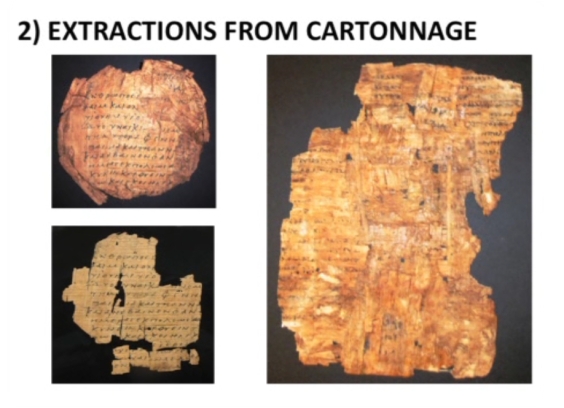I’ve written several posts (like this one) on different aspects of the “Passages” travelling exhibition of the Green Collection that took place between 2011 and the opening of the permanent exhibition at the Museum of the Bible in 2017. Some of the early Christian manuscripts associated with the “Passages” exhibition seem to have gone out of the public eye, as they have not gone on display in the Museum of the Bible.
One of these pieces that I have mentioned before is a papyrus codex containing part of 1 Samuel (identified as GC.PAP.000416.1-.9 in the Verbum Domini II catalog). In the interest of maintaining a public record of all the . . . interesting claims that have been made about this piece, I’m going to add a couple notes here from a new (to me, anyway) and interesting source–a series of lectures given in several US cities in association with the “Passages” exhibit. The online record of these talks seems to have vanished, but the fantastic Wayback Machine preserves a record of the titles of these lectures, such as this one from Colorado Springs in 2013.

Scott Carroll in Oklahoma City in 2011
In any event, it turns out that these lectures are available on DVD. The first series of talks took place in Oklahoma City in 2011. One of the lectures was given by Dirk Obbink of Oxford University. After the lecture, Scott Carroll gave some closing words and brought up the 1 Samuel papyrus:
“I wanna make three observations that relate to the exhibition. Ah, there is in the first room, a segment, on papyrus, of, ah, it’s the beginning of 1 Samuel, very rare and early text of 1 Samuel that came from domestic reuse of papyrus. Um, there are a number of chapters that were found in that by, uh [mumbles] it was a great privilege for me to find that. And there is one section–it is a book, so very likely used by Christians–however there is one major section, inexplicably, that is a scroll. And so it’s a, I can’t explain, it’s, uh, bare, the back, the back side’s barren. And so it’s, it’s just an oddity, and ah, so these things you have to work with the evidence and try to figure them out.”
So . . . both a codex and a scroll? As I said, interesting. And here the 1 Samuel papyrus is said to have come from “domestic reuse of papyrus.” Recall that in a video of the Atlanta “Passages” exhibition, Carroll had explicitly claimed that he had extracted the 1 Samuel papyrus from a mummy:
Carroll: “And so what you have in the back is a papyrus text of the very beginning of 1 Samuel. And, this I recovered from a mummy mask that I dismantled. Yeah! There were, there were seven chapters…This is the earliest text of 1 Samuel in the world.”
Television host: “You found this?”
Carroll: “Oh yeah, this is my research area. And uh, and underneath this, underneath the seven chapters that were recovered was Homer’s Iliad. So the classical Bible.”
In his own lecture in the “Passages” speakers series in Oklahoma City, Carroll again featured the 1 Samuel papyrus and supplied some different information. While showing this slide with a mummy mask and exposed texts (which at first glance appear to be Ptolemaic):

Slide from Scott Carroll’s presentation, “Green Collection, Scientific Breakthroughs, and Bible Translation”
Carroll commented:
“The head covering, my guess would be 400, 500 texts will come out of this mummy mask. Alright? And they’ll be all kind of things. Trust me, they’ll be all kinds of things.”
At this point in the talk, a new slide appears:

Slide from Scott Carroll’s presentation, “Green Collection, Scientific Breakthroughs, and Bible Translation”
“Um, we’ve also worked with mummy–you see they would use papyrus for other things, for, buckets, and you know, they just used discarded papyrus for things [apparently gesturing toward the images on the left] Can you tell–the color is different, ’cause this was painted red–Can you tell that this text came from this? Can you see that? Ok. It did. The answer is yes. Alright?
Two weeks ago, I discovered this piece. Last week I discovered this piece. It’s amazing! I love what I do! I really do! . . .[reads some text from the Samuel papyrus] . . . There it is, right there, came from that–uh, mummy, you know, cartonnage. Ah, what’s underneath it? Up here? Baylor’s publishing with us in the Green Scholars Initiative this fall. Homer. So underneath the biblical text of Samuel were a number of pages of Homer’s Iliad. What a, what a treasure trove! Talk about discovery! I mean that’s discovery! It’s amazing! Here the most popular classical all together, smooshed and used for some, you know, use, at home. Domestic use. It’s fascinating . . . This [papyrus of 1 Samuel] is 150 years earlier than any other. You might say to me, ‘Well how do you know?’ Well, it’s based on the handwriting and stuff like that. So, that’s how I make these estimations. And other people make them with me. So it’s, it’s a collective gathering on these things.
But this text was so important that next spring, our Dead Sea Scroll and Study of the Greek Old Testament–called the Septuagint–for Green Scholars Initiative, is going to be directed by the general editor of the Dead Sea Scrolls, Emanuel Tov, who is the leading scholar on Dead Sea Scrolls in the world. And the thing that motivated him to do it was not our Dead Sea Scrolls. It was the text of Samuel, because nobody’s seen–there, we’ve recovered 14 chapters from various texts, various–things like this.”
So, here Carroll suggests that the “cartonnage” was painted red. He also mentions 14 chapters, rather than the seven chapters from the previous clip, but these 14 are said to come from “various texts,” possibly indicating a different copy of 1 Samuel. And, again we see the statement that “pages” of the Iliad were found “underneath” the leaves of Samuel. And in 2011, Carroll expected the Iliad papyri to be published “in the fall.” I don’t think that ever happened. And, unfortunately, I have still not learned anything about the provenance of this “cartonnage.”
There is a lot to unpack with these videos. There are many hours of footage, and the Oklahoma series from 2011 that I am in the process of watching has many revealing moments that provide insight into the genesis of the collection and the early vision of the Museum of the Bible. More to come.


Pingback: More of Scott Carroll’s Papyri? | Variant Readings